Thurs, Nov 13, 7:00pm at Barlow Community Center. Dr. Megan Shaeffer discusses the history and archaeology of Wood Hollow Metro Park
Historic Hudson Homestead Approved for Demolition
By Christopher Bach, President, Hudson Heritage Association
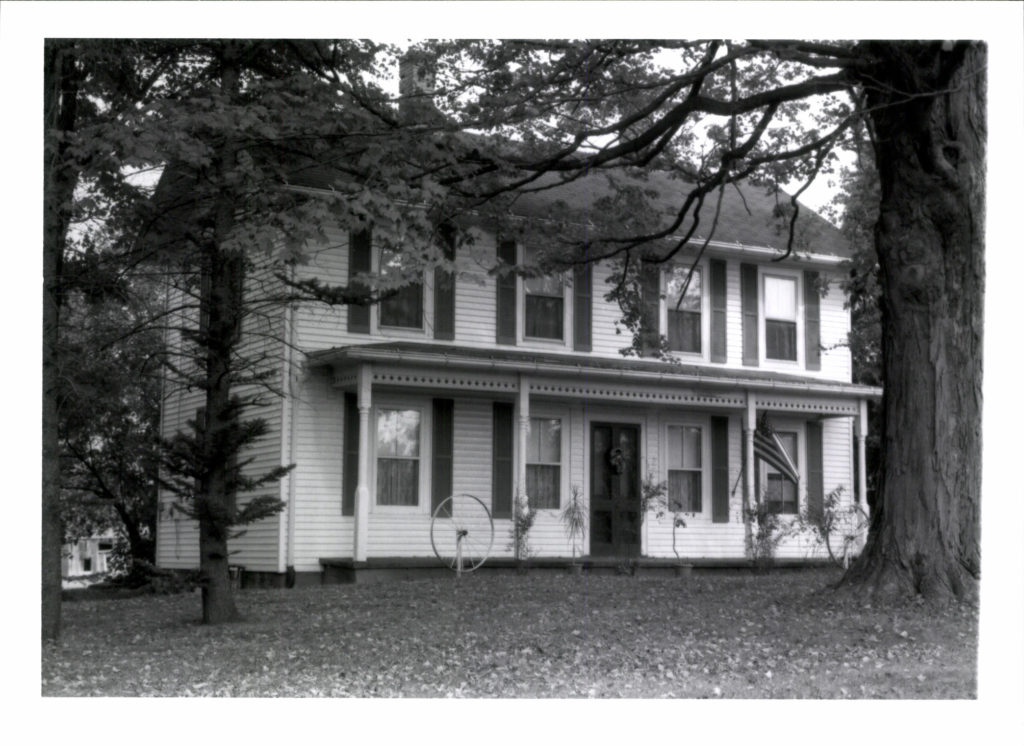
1846 Oviatt-Curtiss House at 1415 Middleton Road, which received a Hudson Heritage Historic Marker in 1996, and was recently approved for demolition.
At the City of Hudson’s Architectural Historic Board of Review (AHBR) meeting on January 22, the board, on which I serve, reviewed a proposal from a potential buyer of the historic 1846 Oviatt-Curtiss farmhouse, including its four outbuildings and a terra cotta silo, located at 1415 Middleton Road. Both the buyer, a couple from Hudson who have made an offer on the property, and a real estate agent from Kurtz Company/Keller Williams Chervenic Realty were in attendance. The Realtor, representing the buyer, presented the couple’s plan to demolish all the historic structures, divide the 5-acre lot into two equal parcels and build two new homes. The plan was submitted by Schumacher Homes, who happens to be the employer of the potential buyer.
The proposal to demolish a historic house in Hudson was shocking… and becoming an all too familiar occurrence. We have seen the character of far too many neighboring historic communities wiped out by the tear-down frenzy.
In October 2019, Hudson lost the 1907 Greenlese House in the Historic District at 37 N. Oviatt Street. The buyer, also employed by and representing a builder, Payne & Payne Builders Inc., initially submitted a proposal to demolish the house and start anew. Because the house was located within the boundaries of the Historic District, greater care was taken to encourage and facilitate preservation of the original house, discouraging demolition, and allowing the owner to discreetly expand the house by adding on to the back. Over the course of 2-3 AHBR meetings, the plans were defined, finalized and approved for a project that included renovation of the existing historic house, an addition, and a new garage toward the back of the property.
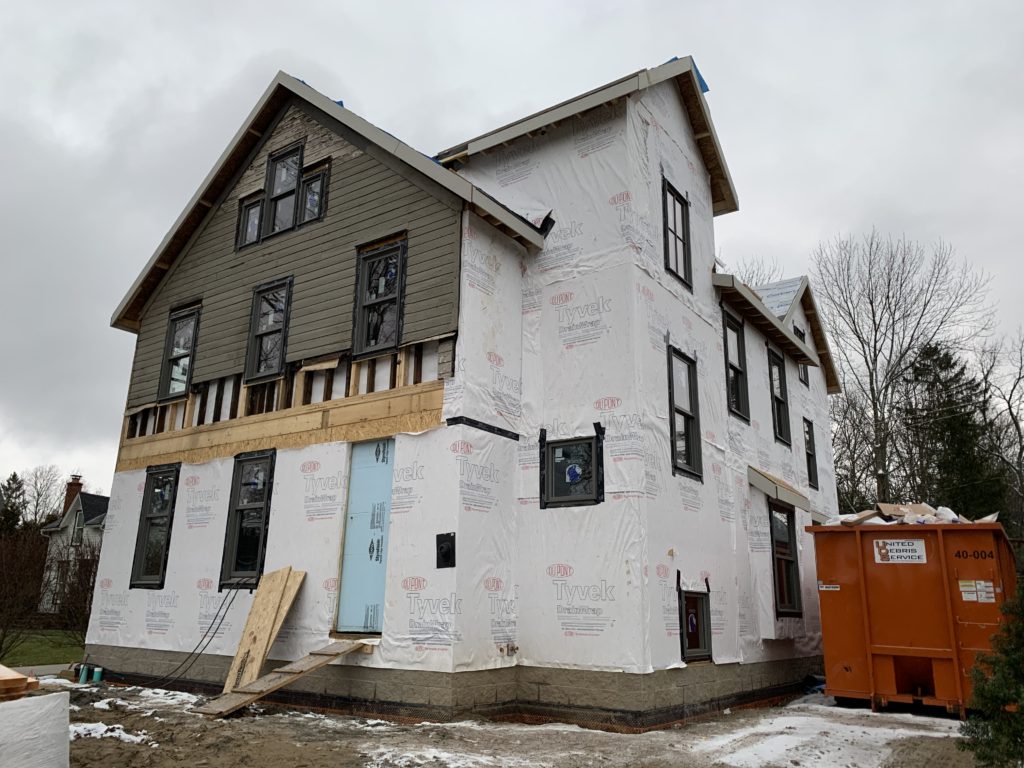
A piece of the original 1907 Greenlese House façade can be seen at 37 N. Oviatt Street, which was demolished in October 2019.
Within a few days during the first week of October, in the shadows and dust of the construction activity of the new Oviatt Street “Old School Green” directly across the street, the entire house was demolished, with only a few miscellaneous pieces of the original façade saved for reuse. This was far from the preservation, renovation and addition project that was approved.
Is this what the future of historic preservation looks like in Hudson’s Historic District and beyond?
The unfortunate demolition of the house at 37 N. Oviatt Street was perhaps an extraordinarily rare occurrence, as it occurred within the Historic District, where there are stringent codes, regulations and a review process that should have prevented a historic structure from simply disappearing overnight.
Now, of equal or more immediate concern, we need to look outside of the Historic District boundaries and focus our attention on the historic structures that were once part of Hudson’s original Township. By recent estimates, there are between 175 and 250 historic structures outside the Historic District, with only 25 of these currently having “Historic Landmark” status (more on this later). All these historic homes and the few remaining farms/homesteads are currently not protected and do not fall within the same guidelines, codes, and strict review process that govern historic homes within the Historic District.
In 1985, through the efforts of many Hudson Heritage Association members and volunteers, HHA completed a survey of all the historic houses in Hudson Village and Township that were constructed before 1940.
“Teams of volunteers from HHA combed the area, photographing houses from all angels and recording architectural and structural details.” This finished survey resulted in a list of 670 structures, all documented on Ohio Historic Inventory forms and filed with the Ohio State Historical Preservation Office. From this impressive list, 384 structures whose “protection was vital to the historic integrity of the Hudson Community,” became the basis of HHA’s book “Hudson: A Survey of Historic Buildings in an Ohio Town” by Lois Newkirk, published in 1989. While many of these historic structures are found within Hudson’s Historic District (established in 1974 and 1998), there are equally as many structures on the peripheral edges that were once part of Hudson Township.
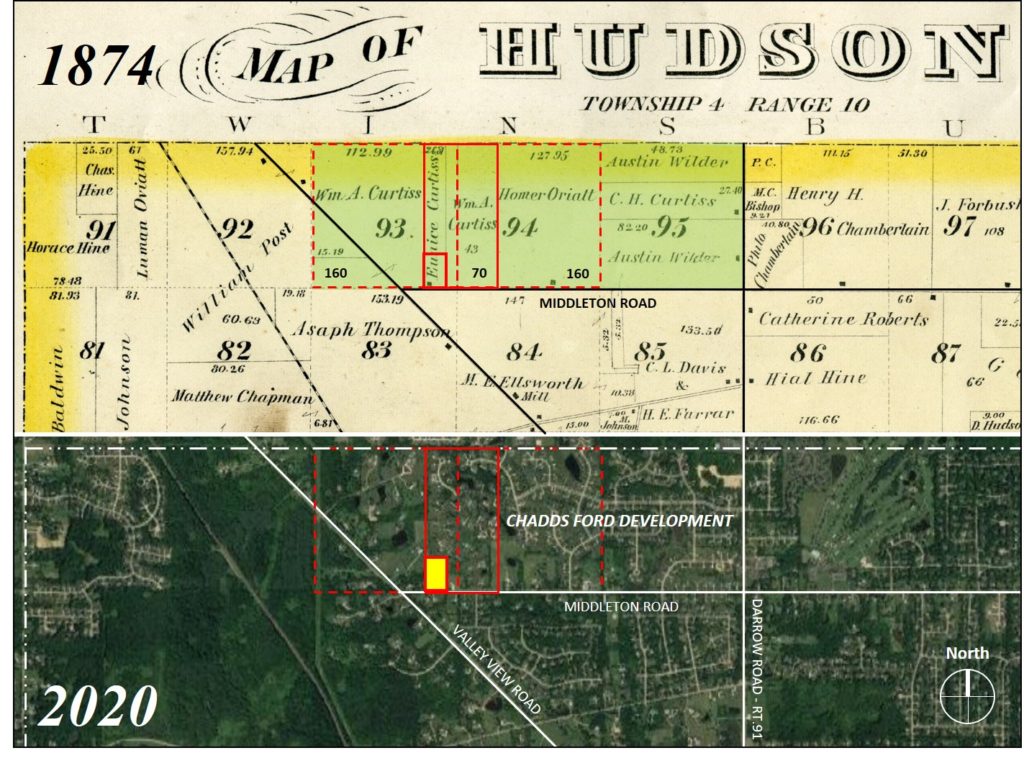
The 1874 Summit County Atlas Map (top) shows a portion of Hudson Township’s northwest quadrant and the original Oviatt-Curtiss property (Great Lots 93 & 94) with 320 acres (highlighted in green). A 2020 Google Maps aerial (below) indicates the remaining 5-acres (in yellow) and the Chadds Ford development of the 1990s.
Middleton Road from Valley View to Stow roads was once called the Middleton-Forbush Road – the Middleton family having lived west of Darrow Road and the Forbush family to the east. This was one of the earliest settlement areas in Hudson Township, perhaps because of its proximity to the early mills. There were seven substantial farmhouses on this road in the 1840s, and four of them still stand today.
The 1846 Oviatt-Curtiss homestead at 1415 Middleton Road is a unique property. Since 1801, it has been owned by only three families: Oviatt/Curtiss (related by marriage), Harper and Ellett. The 1846 Oviatt-Curtiss homestead was at one time a full working farm with 320 acres of land. This was a time when the Western Reserve was reportedly the fastest growing area in the country, with Hudson becoming “a prosperous farming and commercial center with a reputable college to enhance the town’s image.”
Nathaniel Norton of Bloomfield, NY and Birdsey Norton of Goshen, CT, sold all of Great Lot 93 (160 acres) to John Oviatt (1767-1827), one of the original settlers of Hudson, on August 31, 1801, in the presence of, among others, David Hudson, for a sum of $320. Around 1818, Oviatt acquired the adjoining Great Lot 94 (160 acres) to the east, producing a sizeable farm of 320 acres. Through the years, portions of Great Lots 93 and 94 were parceled-off to members of the Oviatt family.
In 1861, granddaughter Eunice M. Oviatt (1832-1911), now married to William A. Curtiss (1832-1906), inherited 26.81 acres of Lot 93 East and acquired most of the balance of Lot 93 the following year. They ran a very successful butter and cheese company. In April of 1898, Eunice and William sold their 70-acre interests in Lots 93 and 94 to William’s brother Augustus Curtiss, for $3,500, but continued to occupy the house. Two years after William’s death, in 1908, Augustus Curtiss sold the 35 acres of Lot 93 East and the 35 acres of Lot 94 West to John Harper for $1, thus ending the 107-year ownership by the Oviatt-Curtiss family.
In January 1920, the Harpers sold the 70-acre farm to Clayton Darrow Ellett (1883-1972) and Ida M. (Phillips) Ellett (1886-1968) for a sum of $11,000. The Ellett family, including their three young sons, Clarence R., Clayton W., and Dwight P., had a homestead in Bedford that had been in the family for more than a century. The Ellett family continued farming at 1415 Middleton-Forbush Road as late as 1954. All three sons also served during World War II. After Clayton and Ida passed away, their son Dwight P. Ellett (1917-2005) continued the farming tradition, cooperating with other local farmers, in particular Paul B. Grissom (1904-1979), to do the cutting, thrashing, bailing, etc., sharing the expensive equipment to get these jobs done.
When the other farms went, it was too much for one farmer on 70 acres to survive, and the farming tradition that was started on the Oviatt property in 1801 came to an end 181 years later, in 1982. That same year, Dwight Ellett re-married Helen Loraine Osburn. In addition to farming, Dwight worked as a school bus driver for the Hudson Local School District for 35 years, retiring in 1982, and Loraine worked in the Evamere School cafeteria. In 1985, the couple formally purchased the historic homestead from family stakeholders, appreciating their unique farmhouse where most of its original fabric remains, and where the Ellett family has continued to live for the last 100 years.
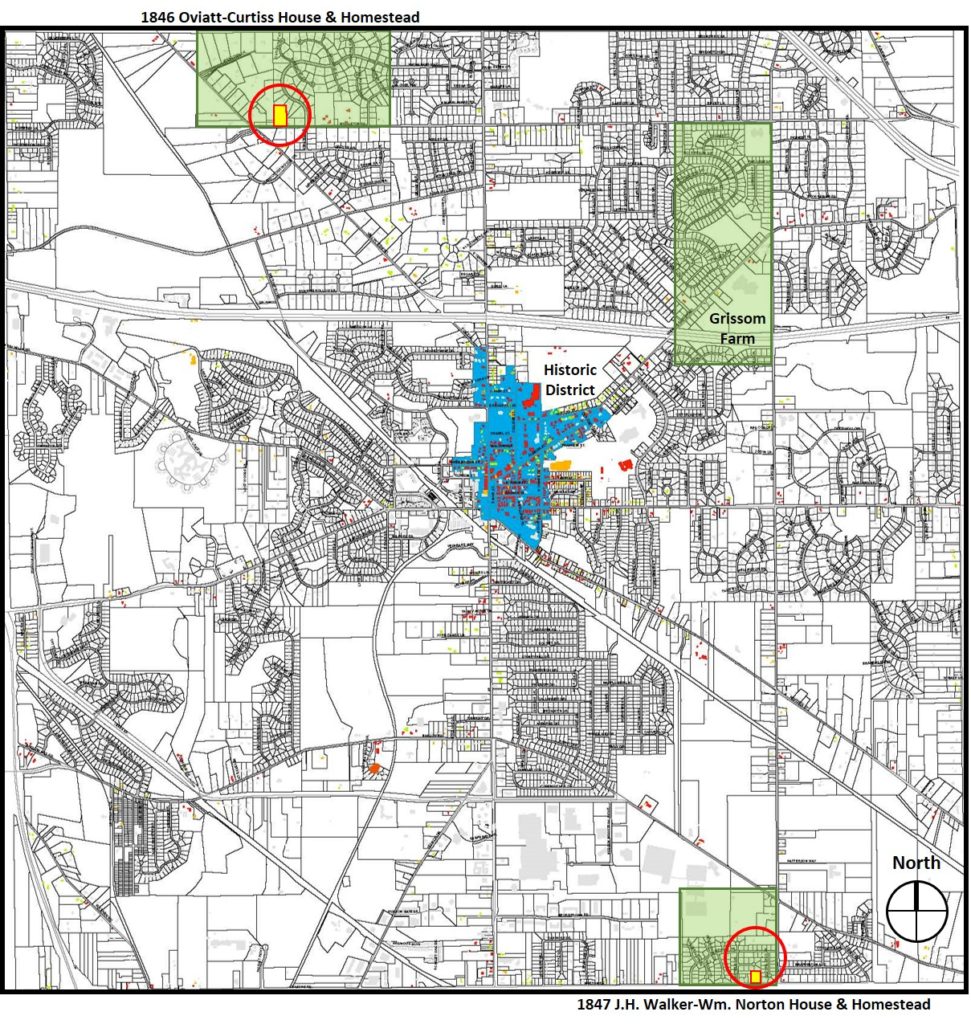
Map illustrating Hudson’s Historic District (in blue) and color-coded structures based on the year built. There are 175-250 historic structures shown outside of the Historic District, built between 1800-1916 (shown in red). A few remaining historic homesteads are highlighted (in yellow w/red circle) with the original acreage shown (in green).
By the mid to late 1980s, Hudson was going through a dramatic transformation and expansion. According to the Akron Regional Development Board at the time, Hudson was one of Summit County’s fastest growing towns. In 1989, the Akron Beacon Journal reported that the “population has more than doubled since 1970 (8,395), and experts predict the population of 17,128 (1990) will jump to 40,000 by the year 2020.”
Housing in the Village and adjoining Township was in such high demand that eager buyers were snapping-up homes from eager developers. Real estate agents and developers were ecstatic! But residents were worried that development “could transform the community’s quiet, semi-rural character into a busy, congested, almost urban personality” according to one resident. By January 1990, more than 25 housing subdivisions were in various stages of construction in the Township. In the Village, where there was less open space, two new subdivisions were being constructed.
The second largest of these developments, after Hudson Park Estates’ 387 lots, was Chadds Ford, with 195 lots planned. By February 1992, ARM Development Corp., which was developing Chadds Ford, had put together enough land in northern Hudson Township that it believed this would be the last large housing development in the area. With 235 acres, the Chadds Ford development had acquired almost every farm, or major portions of them, along Middleton Road between Route 91 to the east and Valley View Road to the west. The 1846 Oviatt-Curtiss homestead at 1415 Middleton Road, which included 70 acres at the time, was sold off for the Chadds Ford development. Fortunately, the Ellett family had the foresight to save the 1846 farmhouse, a large barn with terra cotta silo and four outbuildings, which were re-parceled into a smaller 5-acre lot.
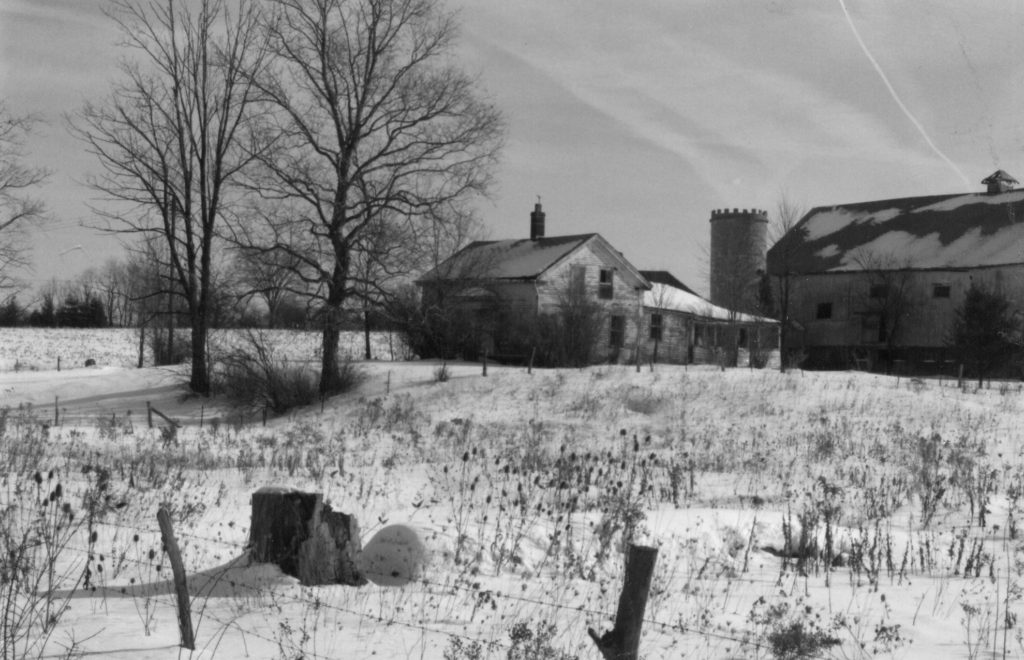
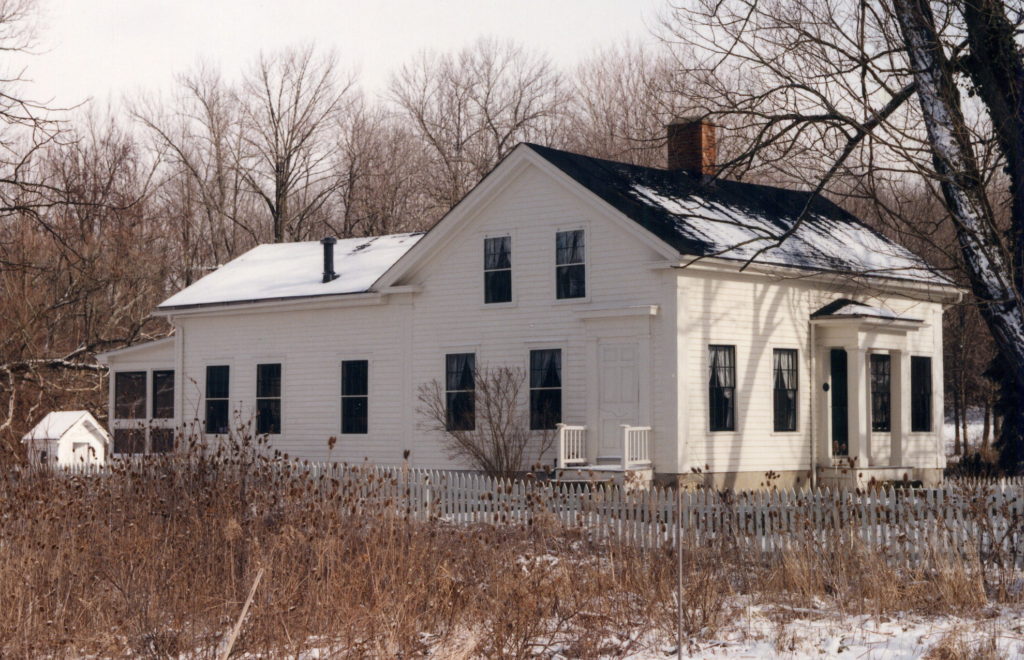
The Grissom farmhouse (1835 Chloe-Wright House) as it appeared on Aurora Road, now the site of the Hudson High School (above). The house was saved and relocated to 63 Owen Brown Street in 1983, where it was beautifully restored and preserved (below).
Just east of the 1846 Oviatt-Curtiss homestead, was the Grissom Farm, which at one time was a thriving 400-acre dairy farm, until most of the land was sold to housing developers in 1961 to make way for the planned Hudson Park Estates that later obscure the horizon of Grissom’s rolling north pasture beyond Aurora Road. Grissom retained approximately 100 acres to raise 70 Black Angus cattle, but eventually this land too was developed, becoming part of the 72-acre new Hudson High School that opened in 1992 at the corner of Hudson-Aurora and Stow roads. With perseverance, the assistance of the Hudson Heritage Association, and willing buyer Katie Coulton, the Grissom farmhouse (1835 Chloe-Wright House) and granary were rescued from threatened demolition and moved to 63 Owen Brown Street in the summer of 1983, where they were restored by house restoration contractor Don Reisig. Four other farmhouses that were located around the township and were destined for demolition by developers, were also moved, restored and protected.
Today, another historic farm, the 1847 John H. Walker-William Norton House and Homestead, owned by Richard Zirbel (former chair of the AHBR) and his wife, Phyllis, at 2271 Norton Road, was awarded the coveted HHA Historic Marker this past fall. The homestead includes a farmhouse and five outbuildings on 2.5 acres, which historically included all of Great Lot 8 (160 acres). While not in the Historic District, the Zirbel house and farm nonetheless was deserving of preservation, and the owners recognized this, as only one of a handful of historic homesteads that still exists in Hudson. Similarly, we believe that the well-preserved historic 1846 Oviatt-Curtiss House and five outbuildings at 1415 Middleton Road deserves equal recognition, preservation and protection.
While Hudson’s population has fortunately never reached the predicted 40,000 by 2020, and large-scale housing development has decreased dramatically from the rural housing development sprawl of the 1980s and 90s, it is these last remaining historic homes, farms and open spaces outside of our Historic District that must now be protected from the whims of developers, the ignorant or uncaring.
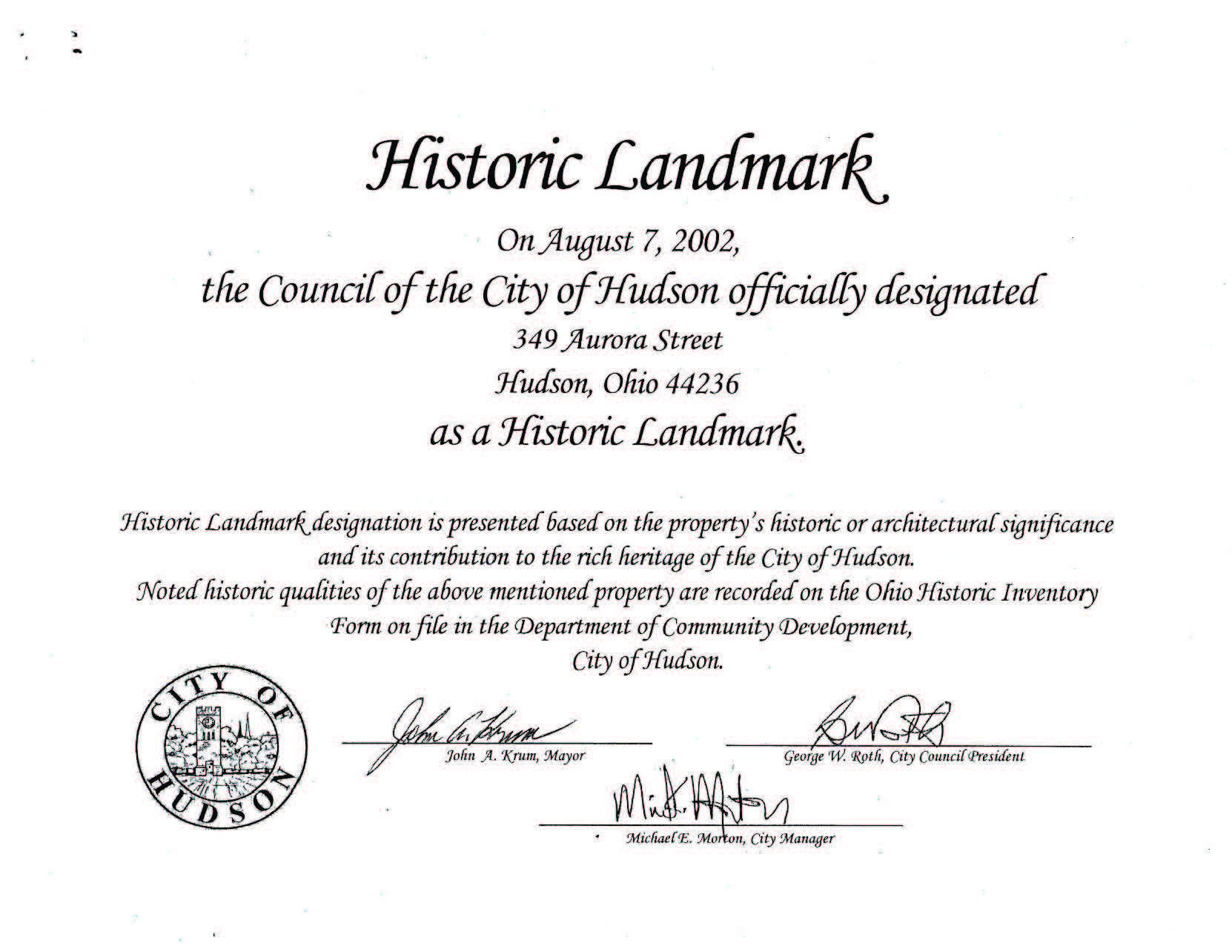
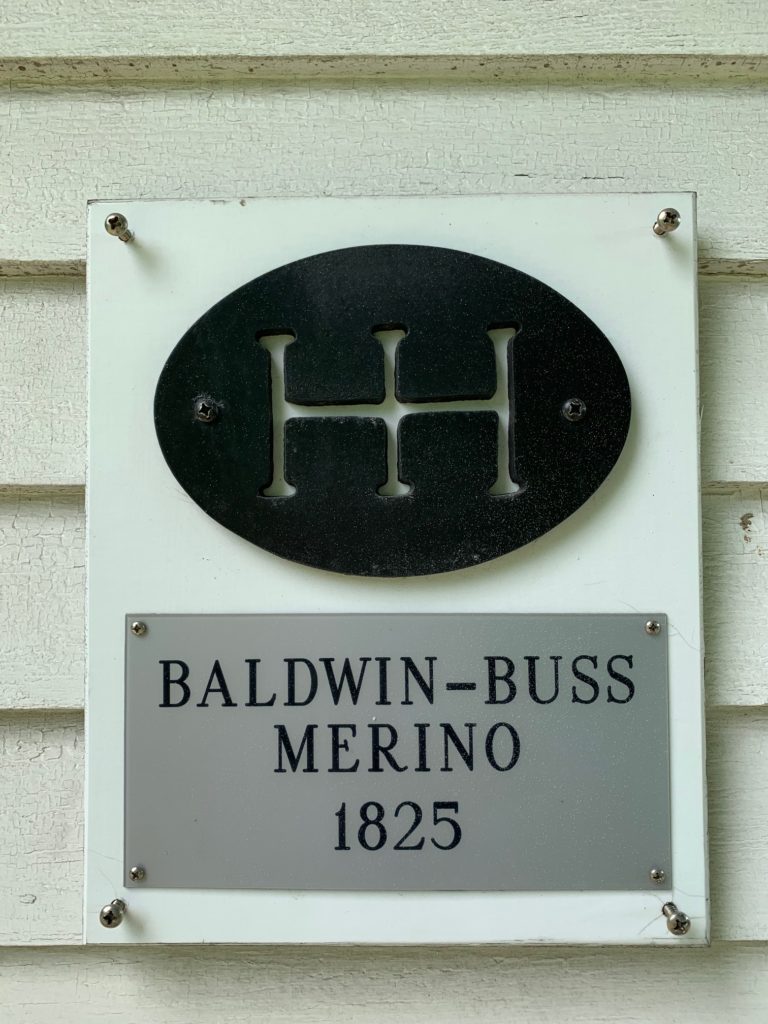
The City of Hudson’s “Historic Landmark” status designation certificate for the 1910 Colonial Revival-style house located at 349 Aurora Street (above). The Hudson Heritage “HH” Historic Marker, awarded to the Baldwin-Buss Merino House in 2008 (below). The Hudson Heritage Marker Program was instituted in 1973, to recognize historic homes, aid in their preservation and is a physical reminder of Hudson’s important heritage.
In 1998, the Hudson Heritage Association, in partnership with the City of Hudson, began to document and catalogue all the historic structures and properties outside of the boundaries of the Historic District, which resulted in a list of approximately 175 structures, built between 1800 and 1910. These structures were to be designated “Historic Landmarks” by the City Council, with a letter sent to homeowners encouraging them to apply for the Historic Landmark status. In 2002, of these approximately 175 structures/properties, only 25 homeowners responded.
Among the 25 responses, were owners Gail and Bill Cordier, who had spent the past 27 years in their Colonial Revival-style house located at 349 Aurora Street. The home was built in 1910 by the McKenzie family, who resided in Cleveland and spent their summers in Hudson. In 1918, the home and 125 acres were purchased by Edward Fitch from Pennsylvania and called the “Weohona Farm.” Since its construction, the home has had nine owners.
In August 2002, after review and recommendations by both the City of Hudson’s Planning Commission and Architectural Historic Board of Review, the City Council officially codified and designated the house and property at 349 Aurora Street and the 24 other homes as having “Historic Landmark” status. Today, without this Historic Landmark designation, hundreds of historic houses/properties are at risk of being demolished. And while many of these historic structures outside of the Historic District, have the coveted Hudson Heritage “HH” Historic Marker, including the 1846 Oviatt-Curtiss Homestead (awarded in 1996) at 1415 Middleton Road, they are not protected from demolition by current or future owners.
Unfortunately, in the end, the Architectural Historic Board of Review could not save the 1846 Oviatt-Curtiss Homestead, because the property was outside of the Historic District and did not have the individual City of Hudson “Historic Landmark” designation status, which would have required a more thorough review and determination. The AHBR was left powerless and could only make a finding on whether the house had “historic and architectural significance,” which we all agreed, it clearly did.
It is now up to the buyers of the 1846 Oviatt-Curtiss Homestead to reconsider their plans for destruction and development in lieu of saving Hudson’s rich architectural history and preserving its fragile agrarian past.
In 2018, the Hudson Heritage Association broadened its Historic Marker Program qualifications to include homes built before 1940 that are of historical, architectural and cultural significance. The City of Hudson is also currently reviewing an expansion of the Historic District to include Elm Street, Roslyn Street, and portions of East Streetsboro Street, with many of these homes built between 1900 to 1940.
In the coming months, the Hudson Heritage Association and the City of Hudson will be collaboratively developing a plan of action that identifies, catalogues/records and defines historic houses outside of the Historic District. Owners of these homes will be contacted and encouraged to participate in the “Historic Landmark” designation program. With homeowner interest and cooperation, it is the hope of HHA that further loss of Hudson’s rich architectural history can be prevented and that there is an end to demolition requests and approvals like the one made for the historic 1846 Oviatt-Curtiss Homestead.